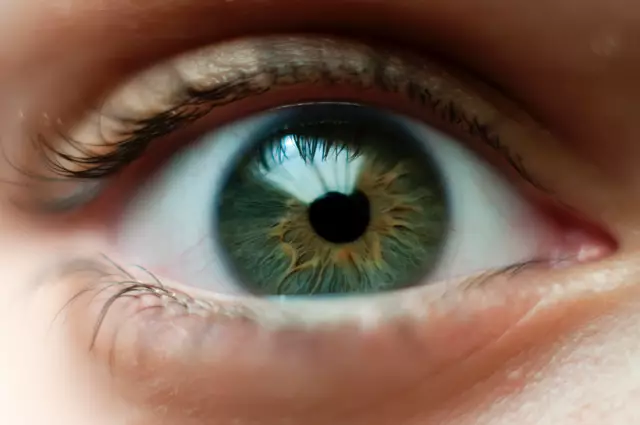- Author Rachel Wainwright [email protected].
- Public 2023-12-15 07:39.
- Last modified 2025-11-02 20:14.
10 interesting facts about eyes and vision
The eyes are a unique organ in structure, thanks to which a person receives about 80% of information about the world around him: about the shape, color, size, movement and other parameters of objects and phenomena. But how much do we know about our most valuable sense organ, which, according to the scientist Sechenov, provides us with about a thousand different sensations per minute? Here are 10 of the most surprising facts about eyes and vision.

Source: depositphotos.com
Fact 1. The average eye diameter is 2.5 cm, weight is about 8 g, and these parameters with a difference in a fraction of a percent are similar in all people who have reached 7 years of age. The diameter of the eye of a newborn child is 1.8 cm, weight is 3 g. Only 1/6 of the organ of vision is visible to humans. The inner part of the eye is connected to the body by the optic nerve, which transports information to the brain.
Fact 2. The human eye can perceive only three parts of the spectrum - green, blue and red. The rest of the distinguishable shades (there are more than 100 thousand) are derived from these three colors. Only 2% of women have an extra retinal area that can recognize up to 100 million shades. All children are born farsighted color blind, unable to perceive colors, however, in 8% of males, color blindness remains in adulthood.
Fact 3. All people are blue-eyed. The difference in shades of the iris depends on the amount of melanin concentrated in it. It is the highest for those with brown eyes, the lowest for those with light eyes. So, all children are born with gray-blue eyes, which acquire their genetic color after 1.5-2 years. Thanks to this, the laser procedure for color correction has become widespread, which clears the iris from melanin. It allows you to change brown eyes to blue in a minute; but it is impossible to return the previous shade.
Fact 4. About 1% of people on the planet have different eye colors - a genetic disorder called heterochromia. This may be the result of trauma, disease, genetic mutations and is explained by an excess of melanin in one organ of vision and its lack in another. With partial (sector) heterochromia, there are areas of different colors on one iris, with absolute - the eyes are entirely of two different colors. More often than in humans, heterochromia occurs in animals - cats, dogs, horses and buffaloes. In ancient times, people with heterochromia were considered sorcerers and witches.
Fact 5. One of the rarest iris shades is green. This beautiful color is due to the presence of a yellow lipofuscin pigment in the outer layer of the iris, combined with a blue or cyan tint in the stroma. It occurs in only 1.6% of the world's population and is eradicated in families with the dominant brown-eyed gene.
Fact 6. The cornea of the human eye in the structure and structure of collagen is similar to shark, which is often used as a substitute for eye surgery. Today, transplantation of the cornea of a marine predator to humans (an achievement of zooophthalmology) is a highly effective method of treating severe organ diseases and restoring vision.
Fact 7. The retina is unique: it has 256 unique characteristics (the probability of repetition in two different people is 0.002%). Therefore, iris scanning, along with fingerprinting, can be used for identification purposes. Already today, the procedure for recognizing a person by the iris of the eye is used in the customs services of the United States and Great Britain.

Source: depositphotos.com
Fact 8. The oculomotor muscle is the fastest in the body. The blinking process takes about 100 milliseconds - or 5 times per second. Every second the lens of the organ of vision can focus on 50 objects, and only intermittently; the eye muscles can make smooth movements only by following a moving object.
Fact 9. We see not with our eyes, but with our brain. The organ of vision only provides the brain with information (and in an inverted form), which its corresponding departments decipher in the form of pictures and images. Thus, if the brain malfunctions, even with normal functioning of the eyes, images may be perceived distorted. One standard eye movement test can detect, with an accuracy of 98%, schizophrenia, a severe mental illness associated with a malfunctioning of thought processes.
Fact 10. The most unusual eye color is red. Due to the absence of melanin in the retina, the iris looks red due to the blood vessels visible through it. From mixing the red eye color and the blue tint of the stroma, a violet color can be obtained (varieties - lilac, ultramarine, amethyst). This deviation is more common in albinos and is extremely rare.
YouTube video related to the article:

Maria Kulkes Medical journalist About the author
Education: First Moscow State Medical University named after I. M. Sechenov, specialty "General Medicine".
Found a mistake in the text? Select it and press Ctrl + Enter.






